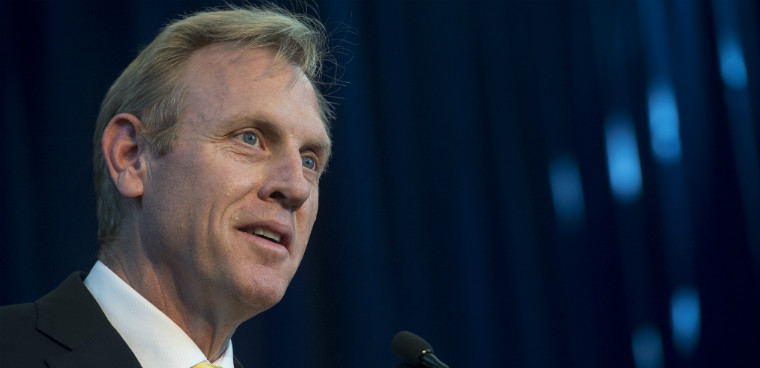What to expect from Shanahan's DOD

The leadership personnel shuffle at the Pentagon has outside observers focused on budget, acquisition and business reforms.

Deputy Secretary of Defense Pat Shanahan speaks during the Defense Intelligence Agency change of directorship ceremony at Joint Base Anacostia-Bolling in Washington. D.C., Oct. 3, 2017 (DOD photo by Air Force Tech. Sgt. Brigitte N. Brantley)
At least for the time being, the Department of Defense is being led by a former contractor with limited government and no active duty military experience. Patrick Shanahan, the former Boeing executive who was elevated to the Pentagon's top job after the departure (or dismissal) of former Marine General Jim Mattis, has a reputation as a private sector problem solver.At Boeing, Shanahan led turnarounds of the 737 Max and 787 Dreamliner program, and earned a reputation of a detail-oriented senior executive.
At his 2017 confirmation hearing, he painted a picture of a technocrat and an ideal deputy.
"I bring strong execution skills with a background in technology, development and business management; areas this committee, in particular, has identified for reforms," he told the Senate Armed Services Committee.
The question is, what kind of boss is he going to make? And will he thrive under President Trump's unpredictable management.
One of the first clues to Shanahan's performance will be his presentation of the Pentagon's budget. At a Jan. 2 cabinet meeting, Trump called Shanahan "a good buyer".
But defense officials haven't provided any information on where the topline fiscal year 2020 budget stands. That plan is set to be delivered to Congress in early February, although the current partial government shutdown is expected to delay the process.
"Shanahan like Mattis before him has to navigate a world in which in the course of December the president varies the defense budget proposal by $50 billion in the course of a few days and a few tweets," said Michael O'Hanlon, a Brookings Institution senior fellow and director of foreign policy research via email. "So the job won't be easy for anyone...and in an era where most agree that the priority should be on reinvigorating our capacity for great-power competition, his ability to work well with industry (and support industry) will be advantages."
Andrew Hunter, director of the defense industrial initiatives group at the Center for Strategic and International Studies, told FCW that a 2020 uncertainty over defense budget leaves room for a lot of change. Shanahan announced a $700 billion cap for 2020 in October, followed by Trump floating a $750 billion budget.
"One of the hardest things to do is deal with a sudden shift in the budget," Hunter said, noting the lasting effects of sequestration cuts in 2013.
Additionally, Shanahan's industry background could serve as a bridge to contractors. "The good news about Shanahan, from an industry perspective, is that he comes from industry, He understands their problems and will be able to talk to them," Hunter said.
Authority flowing down
Steve Grundman, an Atlantic Council senior fellow who owns his own consulting firm, told FCW that "the most important thing to recognize about these events is not Pat Shanahan, it's that they are one man down at the Pentagon." Shanahan and DOD Comptroller David Norquist, who is now performing the deputy secretary duties, hold "the hardest jobs in all of Washington," he said.
DOD's chief management officer position is also now filled in an acting capacity, with Deputy CMO Lisa Hershman stepping in after Jay Gibson left in November.
Grundman said these changes at the top may cause authority to flow downwards, potentially giving DOD Acquisition and Sustainment Under Secretary Ellen Lord and the military service acquisition heads more buying power.
Grundman predicted "the larger significance of this is will be on the program-by-program basis," but said Shanahan's attentions will certainly be divided and drawn to the biggest and most contentious decisions.
Hudson Institute senior fellow William Schneider predicted a relatively smooth transition in the short term, so long as a budget comes out on time. Norquist and Shanahan have been steeped in budget dealings with the service branches, he said, and are keen on the details.
But "if a budget doesn't come out in the next 30 days, there could be some disruption to military functions," Schneider said.
Business reforms, which are part of the National Defense Strategy's nine lines of effort, could also be deprioritized now that Shanahan is in a more outwardly focused role that takes him away from the daily operational churn, said Thomas Spoehr, director of the Heritage Foundation's Center for National Defense.
Another potential bright spot is that with Shanahan in the top defense job, budget talks with Congress could be smoother.



